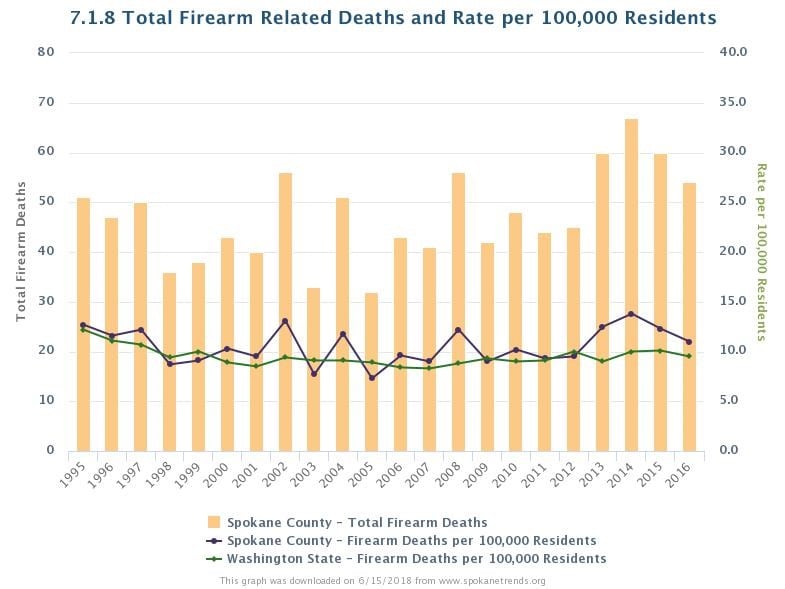Firearm-related death rate in Spokane County higher than state
by Scott Richter and Dr. Patrick Jones
More guns, fewer guns, smart guns, or no guns - everyone has an opinion on the gun debate - everyone, that is, except the Trends project. The pure fact of the matter is all weapons are engineered and manufactured with the ability to cause injury and kill - if someone chooses to or needs to use them in such a way.
With recent high-profile school shootings in Parkland, Florida, Houston, Texas, the mass murder from gunfire in Las Vegas, Nevada, and locally at Freeman High School, now might be a good time to remind everyone that the Trends project is about providing accurate data without advocating an agenda. We hope you find most, if not all, the information and resources for you to make informed personal and professional decisions. With that introduction, the facts are that firearm-related deaths are on the increase.
Statistics from the National Safety Council show across the U.S. in 2016 (the most recent data available), firearm-related deaths were the highest on record. At 38,658, firearm-related deaths in the U.S. have increased by 6.7% since 2015, 15.1% since 2014, and 33.9% since 1999.
According to the Brady Campaign to Prevent Gun Violence, Key Gun Violence Statistics, using a 5-year average for the 2011 through 2015 time period, on average each day in the U.S., approximately 318 people were shot "in murders, assaults, suicides and suicide attempts, unintentional shootings, and police interventions."
Of the 96 gunshot victims who were killed, 34 were murdered, 59 were suicides, and 1 was unintentional. Of the 222 gunshot survivors, 164 were attacked, 10 attempted suicide, and 45 were unintentional. One out of three gunshot victim dies and two out of three gunshot deaths are suicides.
For youth ages 0-19 during the 2011 through 2015 time period, on average each day in the U.S., approximately 47 youth were shot, with approximately 7.5 dying and 39.5 surviving.
Amy Riffe, Epidemiologist with Spokane Regional Health District, who holds a Master's degree in Forensic Anthropology, worked two-years as a crime scene investigator, and also holds a Master's degree
in Public Health. She wrote her thesis on suicide, and says it's important to understand there is both a cause of death as well as the manner of death.
"They are two distinct things. Cause of death is what actually killed you, like a head injury, or from cancer. Manner of death is one of five things: natural, accident, homicide, suicide, and undetermined" said Riffe.
In the case of firearm-related deaths, "natural" is never used and "undetermined" is extremely rare. Riffe says "about 0.6% statewide in 2016 were undetermined, even fewer for unintentional, and around 75% were suicides."
This makes firearm-related deaths more of a personal and public health issue than an overarching public safety issue.
Although most gun laws are established at the state level, there have been some significant federal firearm legislation. Firearm laws in Washington State can be found here, and a complete timeline of federal firearm legislation can be found here.
Examining local data via the Total Firearm Related Deaths and Rate per 100,000 Residents indicator, we can see that there were 54 firearm-related deaths during 2016 in Spokane County, increasing from 51 at the beginning of the series in 1995. 2016 also represented the second consecutive year of a decrease from the previous year. As a rate per 100,000 residents of Spokane County, there were approximately 11.0 firearm-related deaths during 2016, compared to 9.5 in the state.
The decreases produced in 2016, however, were coming off the three highest number of annual firearm deaths in the series in 2013 (60), 2014 (67), and 2015 (60).
Although the trend line is moving in the right direction, the number of firearm-related deaths in three of the last four years in Spokane County were the highest in the series. The lowest of these was only 2 firearm-related deaths away from creating a situation where the four most-recent years in this series were also the four highest.


